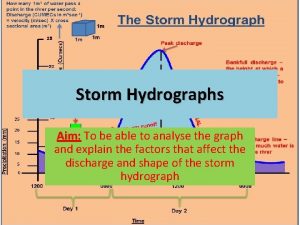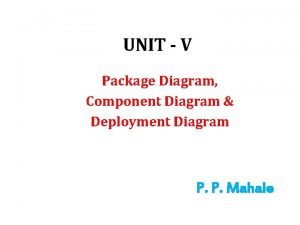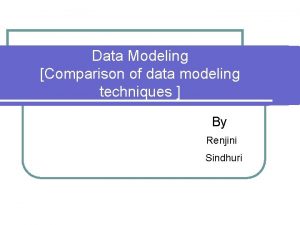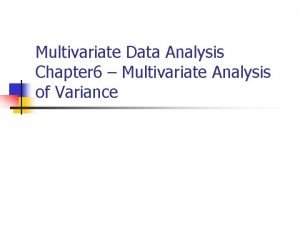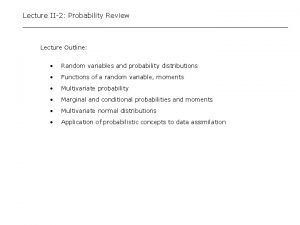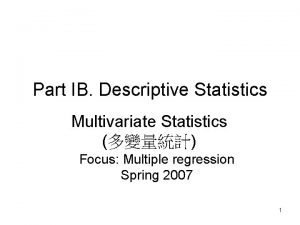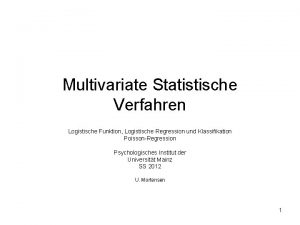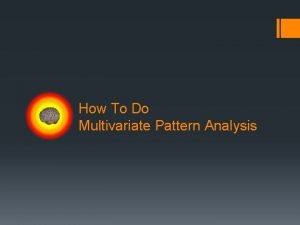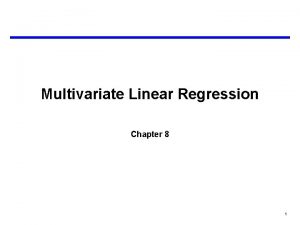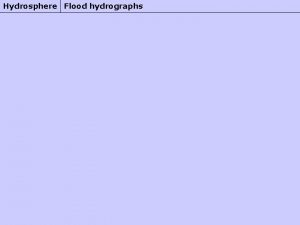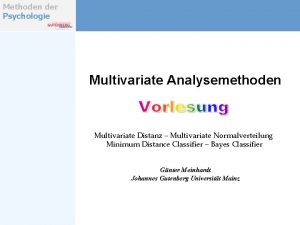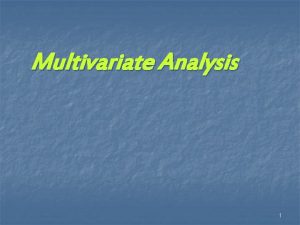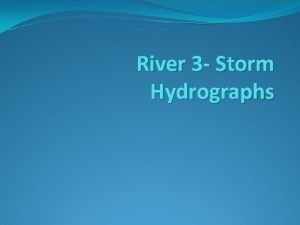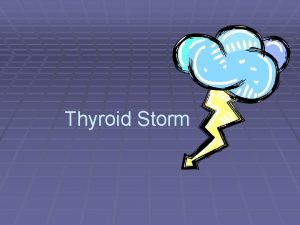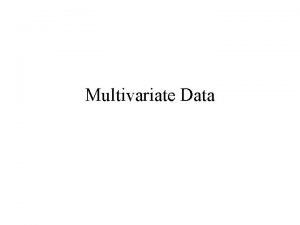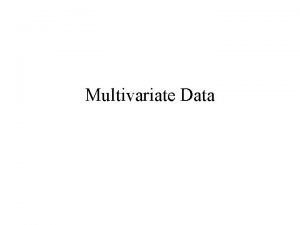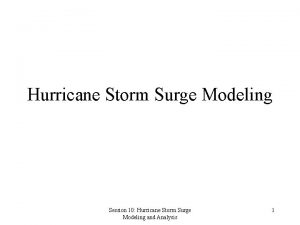Multivariate Techniques for Modeling Storm Hydrographs in the















- Slides: 15

Multivariate Techniques for Modeling Storm Hydrographs in the HJA Experimental Forest Melissa Martin and Julia Jones, Ph. D. Oregon State University

The Watersheds WS 2 WS 8 WS 9 Gradient > 50% 25% > 60% Slope length Median 150 m Median 90 m Median 60 m Size 60 ha 15 ha 9 ha Snow presence 6 mo. at high elev 6 mo. 1 -2 weeks Order Second order basin First order basin Storm events 67 WR, 32 DR, 113 WRS 14 WR, 7 DR, 23 WRS (212) (44) 226 WR, 109 DR, 34 WRS (369)

The Hydrograph

Objectives � Compare peak discharge and precipitation for WR, DR, WRS events for each watershed � Examine relationship of hydrograph variables to intensity/timing of precipitation, under the three soil conditions listed above for each watershed � How are these different across the watersheds?

Principal Component Analysis � � Why consider PCA? What is PCA? - Explains variance-covariance structure - Good for data reduction The ith PC is given by Proportion of total population variance due to the kth PC is equal to

Example: PCA for WS 2 � Examine the 10 hydrograph variables for normality

� Obtain the coefficients of the PC’s Variable ltotalprecip 0. 400 0. 028 -0. 436 0. 144 lmaxprecip -0. 058 0. 162 -0. 465 -0. 833 lprerunoff 0. 172 -0. 623 -0. 166 -0. 190 lstartlag 0. 135 -0. 652 -0. 037 0. 023 lcentroidlag 0. 287 -0. 221 0. 330 -0. 185 ltimetopeak 0. 372 0. 054 0. 015 0. 081 leventdur 0. 445 0. 124 -0. 055 0. 070 lqbase 0. 215 0. 062 0. 599 -0. 440 lqpeak 0. 400 0. 173 -0. 244 0. 077 lrunoffratio 0. 406 0. 243 0. 183 -0. 051 Variance 4. 198 1. 868 1. 217 0. 941 cum % of total var. 42. 0 61. 2 73. 4 82. 8

� How many PC’s to choose? � Four PC’s are included in all principal component analyses

� Biplots: A 2 -dimensional representation

Storm event type for WS 2

PCA results for WS 2, WS 8, WS 9, and event type WS 2 (60 ha) WS 8 (15 ha) WS 9 (9 ha) Gradient Slope length Snow presence > 50% Median 150 m 6 mo. at high elev 25% Median 90 m 6 mo. > 60% Median 60 m 1 -2 weeks PC 1 Magnitude of storm (no maxprecip) Magnitude with maxprecip, no qbase Magnitude, no qbase PC 2 Timing Antecedent vs. timing “Full” timing PC 3 Antecedent wetness vs. Centroidlag, qbase vs. totalprecip and maxprecip Antecedent wetness Event type PCA Fairly consistent-for DR events, PC 3 is measure of maxprecip Fairly consistent-for WR events, PC 3 is measure of peak discharge (instead of qbase) Not consistent, but sample sizes are small

Normality assumptions Not good for WS 9 Not good for WS 8

Areas for future research Statistical models: Factor analysis, two-way MANOVA, blocking, restricted date ranges, PCA regression Hydrograph properties: Getting more storm events for WS 8 (Get. PQ), creating software for HJA

References Slide 1: Photograph courtesy of Julia Jones. Slide 3: HJ Andrews Experimental Forest figure from Perkins and Jones, Snow and physiographic controls, 1997. - Information about the watersheds and event classification: Perkins and Jones, Snow and physiographic controls, 1997. Slide 4: Hydrograph figure from Perkins and Jones, Snow and physiographic controls, 1997. Slide 6: The result quoted is Result 8. 1, found in Johnson, Richard A. and Wichern, Dean W. Applied Multivariate Statistical Analysis, 2002. Fifth edition, Prentice Hall, Upper Saddle River, New Jersey. Page 428.

Thank You Desiree Tullos for creating the EISI program Julia Jones and Tom Dietterich for mentoring help on this research project Reed Perkins for running Get. PQ to create the hydrograph data set The entire HJA staff Fellow EISI participants
 What do hydrographs show
What do hydrographs show Modeling and role modeling theory
Modeling and role modeling theory Relational modeling vs dimensional modeling
Relational modeling vs dimensional modeling Common modeling techniques of deployment diagram
Common modeling techniques of deployment diagram Idefix notation
Idefix notation What is multivariate
What is multivariate Multivariate analysis
Multivariate analysis Multivariate statistical analysis
Multivariate statistical analysis Multivariate analysis of variance and covariance
Multivariate analysis of variance and covariance Multivariate pdf
Multivariate pdf Multivariate descriptive statistics
Multivariate descriptive statistics Logistisches wachstum ableitung
Logistisches wachstum ableitung Multivariate methods in machine learning
Multivariate methods in machine learning Multivariate regression spss
Multivariate regression spss Multivariate pattern analysis
Multivariate pattern analysis Multivariate analysis
Multivariate analysis
